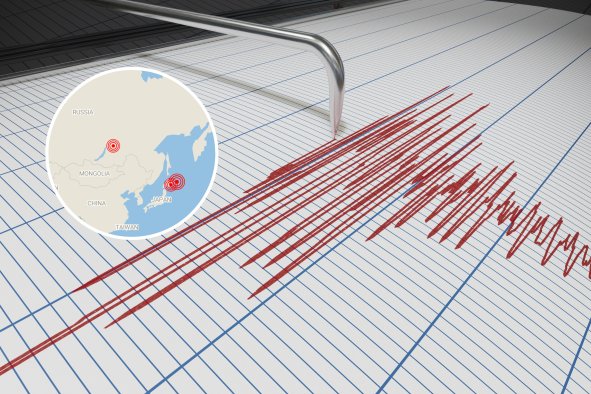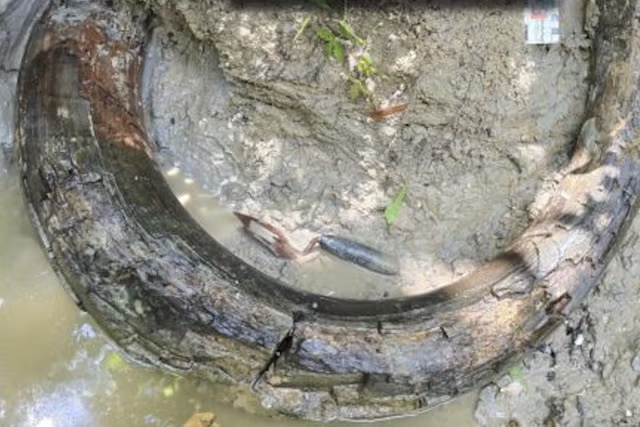The search is on for missing passengers after a rare meteorological phenomenon known as a waterspout struck and sunk a luxury sailing yacht off the coast of Sicily on Monday.
A number of people remain missing, including the British billionaire Mike Lynch, and Morgan Stanley International bank chairman Jonathan Bloomer.
Fifteen others aboard the yacht, the Bayesian, were rescued, including Lynch's wife Angela Bacares, with several being taken to hospital.
While authorities try to piece together exactly what happened, early indications suggest that abnormally high water temperatures in the Mediterranean likely led to the formation of a kind of waterspout—a ferocious column of rotating air and mist—that engulfed the ship.
What is a waterspout?
Waterspouts are atmospheric phenomena that form as rotating columns of air beneath thunderstorms over bodies of water.
These swirling vortexes belong to the same meteorological family as tornadoes, sharing similar formation processes and characteristics.
"Generally speaking, a waterspout is a type of tornado that forms over water," Jana Houser, an associate professor of meteorology at Ohio State University, told Newsweek.
"There are some differences between how a waterspout and a traditional tornado forms, but they're in the same family."
While many waterspouts are relatively brief and mild, lasting only seconds and producing moderate gusts, some can develop into more potent and enduring systems. The intensity spectrum of waterspouts ranges from barely noticeable disturbances to powerful, potentially hazardous, weather events.
"They can occur all over, even across the Great Lakes in the United States, the Gulf of Mexico. Pretty much anywhere where there is a contrast between warm water and the shore," Houser said.
Despite their sometimes impressive appearance, waterspouts generally cause less damage than their land-based counterparts due to their occurrence over water. Any vessels caught in a waterspout's path, however, are at significant risk.
"Heat and humidity in the lower atmosphere are the two main requirements [for waterspout formation], and over the Mediterranean in late summer and autumn, there are plenty of both," Peter Inness, a meteorologist at the University of Reading in the U.K., said in a statement.
"Changes in wind direction with height are also needed to set up the rotation of air within the waterspout."
In short, a preexisting rotation in the air is needed, which when combined with an upward motion of air under a thunderstorm over water, forms a waterspout.
"The thunderstorm basically ingests the rotation upward through the storms updraft and causes it to spin faster and faster as it does so," Houser said.
How Dangerous Are Waterspouts?
While most waterspouts are weak and short-lived, winds of over 100 mph can quickly form.
"Actual wind measurements from inside waterspouts are very rare indeed," Inness said.
"Winds of this strength coinciding with the location of a boat are capable of causing damage or capsize, especially because the wind direction varies very rapidly within a waterspout which could cause a boat to rock violently."
In the past, waterspouts have been "known to overturn boats, damage large ships, and put lives in jeopardy," according to the National Oceanic and Atmospheric Administration.
Was This Definitely a Waterspout?
It's clear that a violent storm hit the superyacht in the early hours of the morning, with witnesses to the event saying that the boat disappeared in just 60 seconds, as reported by the Italian news agency Ansa.
"You would normally expect a traditional waterspout to form during late afternoon hours after you've had a lot of surface heating. There's no way this is like a traditional waterspout because it happened in the middle of the night," Houser said.
Houser explained that this could therefore mean the event occurred more like a traditional tornado, where the storm itself was rotating, saying: "These tend to be a considerably more intense than the a typical waterspout."
"The effect is similar, but it's technically not forming in the same way that a traditional waterspout would, and that's probably why this was potentially so intense and destructive."
Is Climate Change Making Waterspouts More Common?
With rising ocean temperatures largely being chalked up to climate change, it is possible the conditions to form waterspouts will become more frequent—though the picture is far from black-and-white.
However, above average sea temperatures certainly played a role in the events that unfolded on Monday morning.
"The sea surface temperature around Sicily was around 30 degrees Celsius (86 Fahrenheit), which is almost 3 degrees more than normal. This creates an enormous source of energy that contributes to these storms," Luca Mercalli, president of the Italian Meteorological Society, told Reuters.
But whether this is solely a reflection of climate-change-driven factors is less easy to pin down.
"Mediterranean waters could definitely contribute to creating a more robust environment that is supportive of the parent thunderstorm that could produce the tornado," Houser said. "But tornadoes and the like are very localized events that aren't always a function of the broader climatological environment."
"Currently, there's no evidence to suggest, at least not in the U.S., that tornado and waterspout events are increasing in frequency."
Do you have a tip on a science story that Newsweek should be covering? Do you have a question about waterspouts? Let us know via science@newsweek.com.
Disclaimer: The copyright of this article belongs to the original author. Reposting this article is solely for the purpose of information dissemination and does not constitute any investment advice. If there is any infringement, please contact us immediately. We will make corrections or deletions as necessary. Thank you.



